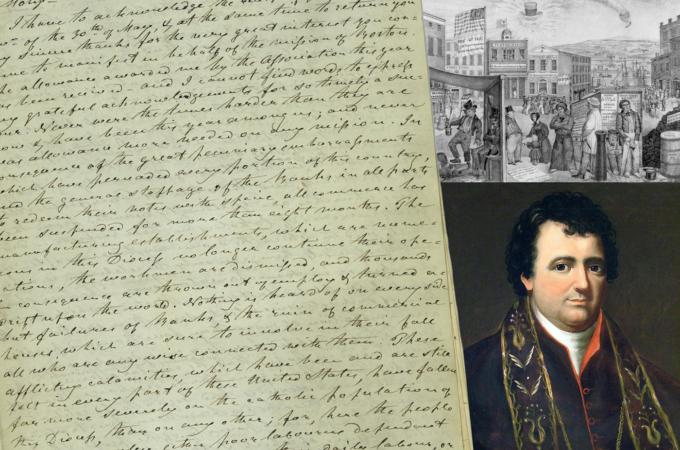The Panic of 1837
On Aug. 29, 1837, Bishop Benedict Joseph Fenwick of Boston wrote a report to the Society for the Propagation of the Faith in Rome, describing the present state of the Diocese of Boston which then encompassed all of New England. He opens the report by describing the effects of the financial Panic of 1837 and, in particular, its effect upon New Englanders.
The Panic of 1837 was a financial crisis which took place during Martin Van Buren's presidency, but the causes are largely attributed to the preceding administration under Andrew Jackson. Over speculation in real estate, largely spurred by the removal of the Native Americans westward, was a large contributing factor.
In 1836, Jackson also chose not to renew the Second Bank of the United States which controlled public credit and helped maintain a stable national currency. This allowed smaller banks to issue their own paper currency, but the Federal government subsequently issued a policy that all Federal land must be purchased in gold or silver, and the banks refused to exchange hard currency for the paper they had previously issued.
This caused a financial collapse, which Bishop Fenwick describes in his report as "the great pecuniary embarrassment which has pervaded every portion of this country." He continues that the banks' refusal to exchange paper notes for specie has suspended all commerce for the previous eight months, and that "nothing is heard of on every side but failures of Banks, of the ruin of commercial houses, which are sure to involve in their fall all who are anyway connected with these."
He describes the plight of New England, in particular, where the crisis has "fallen far more severely on the Catholic population of this Diocese, than on any other." He explains that "here the people being, either poor laborers depending for the subsistence upon their daily labor, or persons hired in factories, have no resource left them under afflictions like these." These workers, now unemployed, were wandering from city to city, village to village, looking for work. Meanwhile, their families were starving, and sought relief through charity.
The effects upon the diocese, he notes, include the halt in construction on a new church in Providence, Rhode Island, and his decision not to commence construction on two churches planned for Fairfield, Connecticut, and Saint Alban's, Vermont. These are desperately needed, he writes, as the Catholic population in each place has increased significantly, and they are forced to rent a meeting house or hold Mass in a private home whenever a priest is able to visit.
Two churches completed in Boston the previous year were also under threat. Between the two they can accommodate over 4,000 parishioners, and they had hoped to pay down the debt significantly, but due to the crisis, can barely afford to support the three priests serving them.
Bishop Fenwick expresses thanks for the relief the Propagation of the Faith has provided in light of the situation in his diocese, stating "the allowance awarded me by the Association this year has been received, and I cannot find words to express my grateful acknowledgements for so timely a succor. Never were the times harder than they are now and have been this year among us; and never was allowance more needed on any mission."
Ending his discussion of the Panic, he expresses his hope for fast relief from the present situation. "How long it may continue God only knows. There are many who think that the worst is not yet come. I pray God that this may not be the case -- and that he will in mercy to the poor abridge the duration..."
His report runs 26 pages, and includes a detailed report of his summer travels throughout the Diocese of Boston, the growing Catholic population, and the greater acceptance of Catholics by the local population. Regretfully, it would be another six years before the nation fully recovered from the Panic of 1837.
- Thomas Lester is the archivist of the Archdiocese of Boston.



















